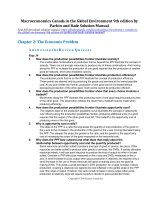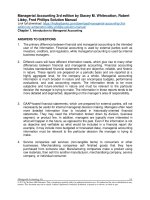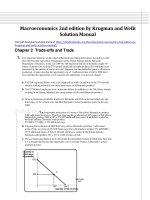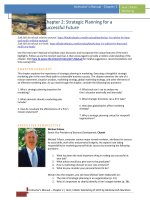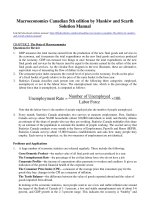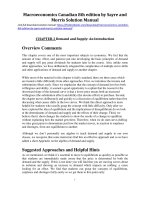Managerial economics 8th edition by samuelson and marks solution manual
Bạn đang xem bản rút gọn của tài liệu. Xem và tải ngay bản đầy đủ của tài liệu tại đây (525.2 KB, 20 trang )
Managerial Economics 8th edition by William F. Samuelson, Stephen G.
Marks Solution Manual
Link full download: />CHAPTER TWO. OPTIMAL DECISIONS USING MARGINAL ANALYSIS
OBJECTIVES
1.
To introduce the basic economic model of the firm (A Simple Model of
the Firm)
- The main focus is on determining the firm’s profit-maximizing level of
output.
- The main assumption is that there is a single product (or multiple,
independent products) with deterministic demand and cost.
2.
To depict the behavior of price, revenue, cost, and profit as output varies.
(A Microchip Manufacturer)
3.
To explain the notion of marginal profit (including its relationship to
calculus) and show that maximum profit occurs at an output such that
marginal profit equal zero. (Marginal Analysis)
4.
To reinterpret the optimality condition in terms of the basic components,
marginal revenue and marginal cost. (Marginal Revenue and Marginal
Cost)
5.
To illustrate the uses of sensitivity analysis. (Sensitivity Analysis)
TEACHING SUGGESTIONS
I. Introduction and Motivation
John Wiley & Sons
2-1
A. This is a “nuts and bolts” chapter. Because it appears up front in the text,
it’s important to explain the motivation and assumptions. It is a good
idea to remind students of the following points.
John Wiley & Sons
2-2
1) The model of the firm is deliberately simplified so that its logic is laid bare.
Many additional complications will be supplied in later chapters. The key
simplifications for now are:
• The model is of a generic firm. Although microchips are chosen to make
the discussion concrete, there is no description of the kind of market or the
nature of competition within it. The description and analysis of different
market structures comes in Chapters 7 through 10.
• Profit is the sole goal of the firm; price and output are the sole decision
variables.
• The description of demand and cost is as “bare bones” as it gets. The
demand curve and cost function are taken as given. (How the firm might
estimate these are studied in Chapters 3 through 6.)
B. In general, our policy is to use extended decision examples, different than
the ones in the text, to illustrate the most important concepts. (Going over
the same examples pushes the boredom envelope.) In the present chapter,
we make an exception to this rule. It is important to make sure that
students with different economic and quantitative backgrounds all get off
roughly on the same foot. Reviewing a familiar example (microchips)
makes this much easier.
II.
Teaching the “Nuts and Bolts”
A. Graphic Overview. The text presents the revenue, cost, and profit
functions in three equivalent forms: in tables, in graphs, and in equations.
In our view, the best way to convey the logic of the relationships is via
graphs. (The student who craves actual numbers can get plenty of them
in the text tables.) Here is one strategy for teaching the nuts and bolts:
1. Using the microchip example, depict the demand curve, briefly note its
properties and demand equation (in both forms).
John Wiley & Sons
2-3
2.
Next focus on revenue, noting the tradeoff between price and quantity.
Present and justify the revenue equation. Graph it and note its properties.
3.
Repeat the same process with the cost function (reminding students about
fixed versus variable cost). At this point, your blackboard graph should
be a copy of Figure 2.8. Steps 1-3 should take no more than 20 minutes.
4.
Since the gap between the revenue and cost curves measures profit, one
could find the optimal output by carefully measuring the maximum gap
(perhaps using calipers). Emphasize that marginal analysis provides a
much easier and more insightful approach. Point out the economic
meaning of marginal cost and marginal revenue. Note that they are the
slopes of the respective curves.
5.
Next argue that the profit gap increases (with additional output) when
MR > MC but narrows when MR < MC. (On the graph, select quantities
that are too great or too small to make the point.) Identify Q* where the
tangent to the revenue curve is parallel to the slope of the cost function.
In short, optimal output occurs where MR = MC.
B. Other Topics. The approach in part A provides a simple way of conveying
the basic logic of marginal analysis using the components of MR and
MC. Once this ground is covered, the instructor should emphasize other
basic points:
1.
2.
3.
4.
The equivalence between Mπ = 0 and MR = MC.
Calculus derivations of Mπ, MR, and MC.
The exact numerical solution for the microchip example.
The graphs of MR and MC and an exploration of comparative statics
effects (shifts in the curves) and the effects on Q*.
C. Applications. Besides the applications in the text, the following problems
are recommended: Problem 1 (a quick but important check), Problems 6,
7 and 9 (numerical applications), Problem 11 (the general solution), and
John Wiley & Sons
2-4
Problem 12. (If the class has a good grasp of this last problem, nothing
else will seem difficult.)
Here is a stylized example that nicely illustrates marginal analysis.
1. SITING A SHOPPING MALL
A real-estate developer is planning the construction of a large shopping
mall in a coastal county. The question is where to locate it. To help her
in the decision, the developer has gathered a wealth of information,
including the stylized “map” of the region in the accompanying figure.
The county’s population centers run from west to east along the coast
(these are labeled A to H), with the ocean to the north. Since available
land and permits are not a problem, the developer judges that she can
locate the mall anywhere along the coast, that is, anywhere along line
segment AH. In fact, the mall would be welcome in any of the towns
due to its potential positive impact on the local economy.
According to an old adage, “The three most important factors in the
real-estate business are location, location, and location.” Accordingly,
the developer seeks a site that is proximate to as many potential
customers as possible. A natural measure of locational convenience is
the total travel miles (TTM) between the mall and its customer
population. Thus, Figure 2.1 notes the distances between towns in the
county. It also shows the potential number of customers per week in
each town. The developer’s key question is: Where along the coast
should the mall be located to minimize the total travel miles?
Figure 1 Locating a Shopping Mall
Number of Customers per week (thousands)
15 10
10 10 5
20 10
15
West ______________________________________ East
A|
B
C D E
F G
H
3.0
3.5
2.0 2.5
4.5
2.0
4.5
Distance between Towns (miles)
John Wiley & Sons
2-5
Answer
We could try to find the best location by brute force – by selecting
alternative sites and computing the TTM for each one. For example,
the TTM at the possible site labeled X (1 mile west of town C) is
(5.5)(15) + (2.5)(10) + (1.0)(10) + (3.0)(10)
+ (5.5)(5) + (10.0)(20) + (12.0)(10) + (16.5)(15) = 742.5.
The TTM is found by multiplying the distance to the mall by the
number of trips for each town (beginning with A and ending with H)
and summing. However, the method requires a good deal of
computational effort while offering no guarantee that an optimal
location (i.e., one that has the lowest TTM of all possible candidates)
will be found. The method only claims that its choice is the best of the
limited number of candidates for which TTMs have been computed.
It is far easier to determine the mall’s optimal location using
marginal analysis. Hint: Begin with an arbitrary location, say, point X.
(Do not compute its TTM.) Instead, consider a small move to a nearby
site, such as town C. Then compute the change in the TTM of such a
move.
Marginal analysis identifies the optimal location as town E. The
demonstration involves a number of steps following a very simple logic.
First consider the move from location X to Town C. Making this move,
we see that TTM must decline. The eastward move means a 1-mile
reduction in travel distance for all customers at C or farther east (70,000
trip-miles in all). Therefore, the TTM is reduced by this amount. Of
course, travel distances have increased for travelers at or to the west of
X. For these customers, the TTM increase is 25,000 trip-miles.
Therefore, the net overall change in TTM is -70,000 + 25,000 = -45,000
trip-miles. Total TTM has declined because the site moved toward a
greater number of travelers than it moved away from. Town C, therefore,
is a better location than site X.
John Wiley & Sons
2-6
Because the original move was beneficial, we try moving farther east,
say, to town D. Again, the move reduces the TTM. (Check this.) What
about a move east again to town E? This brings a further reduction.
What about a move to town F? Now we find that the TTM has
increased. (By how much?) Moreover, any further moves east would
continue to increase the TTM. Thus, town E is the best site.
The subtlety of the method lies in its focus on changes. One need never
actually calculate a TTM (or even know the distances between towns)
to prove that town E is the optimal location. (We can check that town
E’s TTM is 635.) One requires only some simple reasoning about the
effects of changes.
Here is a second application.
2. a. For five years, an oil drilling company has profitably operated in the state
of Alaska (the only place it operates). Last year, the state legislature
instituted a flat annual tax of $100,000 on any company extracting oil (or
natural gas) in Alaska. How would this tax affect the amount of oil the
company extracts? Explain.
b. Suppose instead that the state imposes a well-head tax, let’s say a tax of
$10.00 on each barrel of oil extracted. Answer the questions of part a.
c. Finally, suppose that the state levies a proportional income tax (say 10%
of net income). Answer the questions of part a. What would be the effect
of a progressive tax?
d. Now suppose that the company has a limited number of drilling rigs
extracting oil at Alaskan sites and at other sites in the United States. What
would be the effect on the company’s oil output in Alaska if the state levied
a proportional income tax as in part c?
John Wiley & Sons
2-7
Answer
a.
This tax acts as a fixed cost. As long as it remains profitable to produce
in Alaska, the tax has no effect on the firm’s optimal output.
b.
The well-head tax increases the marginal cost of extraction by $10.00 per
barrel. The upward shift in MC means the new intersection of MR and
MC occurs at a lower optimal level of output.
c.
The income tax (either proportional or progressive) has no effect on the
company’s optimal output. For instance, suppose that the company’s
after-tax income is:
= .9(R-C) under a 10% proportional tax. To
maximize its after-tax income, the best the company can do is to continue
to maximize its before-tax income. Another way of seeing this is to note
that the tax causes a 10% downward shift in the firm’s MR and MC
curves. With the matching shift, the new intersection of MR and MC is
at the same optimal quantity as the old intersection.
d.
When the firm operates in multiple states with limited drilling rigs, using
a rig in Alaska means less oil is pumped (and lower profit is earned)
somewhere else. There is an opportunity cost to Alaskan drilling. Thus,
one can argue that before the tax, the company should have allocated rigs
so as to equate marginal profits in the different states. With the tax, the
marginal profit in Alaska is reduced, prompting the possible switch of
rigs from Alaska to other (higher marginal profit) locations.
D. Mini-case: Apple Computer in the Mid-1990s
The mini-case reproduced on the next page provides a hands-on
application of profit maximization and marginal analysis.
Answer
a. Clearly, the period 1994-1995 was marked by a significant adverse
shift in demand against Apple due to major enhancements of
competing computers: lower prices, better interfaces (Windows), sales
to order (Dell), and more abundant software.
John Wiley & Sons
2-8
b. Setting MR = MC implies 4,500 - .3Q = 1,500, so Q* = 10,000 units
and P = $3,000. Given 1994’s state of demand, Apple’s 1994
production strategy was indeed optimal.
c. In 1995, demand and MR have declined significantly. Now, setting
MR = MC implies 3,900 - .3Q = 1,350, so Q* = 8,500 units and P =
$2,625. Apple should cut its price and its planned output.
John Wiley & Sons
2-9
Apple Computer in the Mid 90s
Between 1991 and 1994, Apple Computer engaged in a holding action in the desktop
market dominated by PCs using Intel chips and running Microsoft’s operating system.1
In 1994, Apple’s flagship model, the Power Mac, sold roughly 10,000 units per month at
an average price of $3,000 per unit. At the time, Apple claimed about a 9% market share
of the desktop market (down from greater than 15% in the 1980s).
By the end of 1995, Apple had witnessed a dramatic shift in the competitive environment.
In the preceding 18 months, Intel had cut the prices of its top-performing Pentium chip by
some 40%. Consequently, Apple’s two largest competitors, Compaq and IBM, reduced
average PC prices by 15%. Mail-order retailer Dell continued to gain market share via
aggressive pricing. At the same time, Microsoft introduced Windows 95, finally offering
the PC world the look and feel of the Mac interface. Many software developers began
producing applications only for the Windows operating system or delaying development
of Macintosh applications until months after Windows versions had been shipped. Overall,
fewer users were switching from PCs to Macs.
Apple’s top managers grappled with the appropriate pricing response to these competitive
events. Driven by the speedy new PowerPC chip, the Power Mac offered capabilities and
a user-interface that compared favorably to those of PCs. Analysts expected that Apple
could stay competitive by matching its rivals’ price cuts. However, John Sculley, Apple’s
CEO, was adamant about retaining a 50% gross profit margin and maintaining premium
prices. He was confident that Apple would remain strong in key market segments – the
home PC market, the education market, and desktop publishing.
Questions.
1.
What effect (if any) did the events of 1995 have on the demand curve for Power
Macs? Should Apple preserve its profit margins or instead cut prices?
2.
a) In 1994, the marginal cost of producing the Power Mac was about $1,500 per unit,
and a rough estimate of the monthly demand curve was: P = 4,500 - .15Q. At the time,
what was Apple’s optimal output and pricing policy?
b) By the end of 1995, some analysts estimated that the Power Mac’s user value (relative
to rival PCs) had fallen by as much as $600 per unit. What does this mean for Apple’s new
This account is based on J. Carlton, “Apple’s Choice: Preserve Profits or Cut Prices,” The
Wall Street Journal, February 22, 1996, p. B1.
1
John Wiley & Sons
2-10
demand curve at end-of-year 1995? How much would sales fall if Apple held to its 1994
price? Assuming a marginal cost reduction to $1,350 per unit, what output and price policy
should Apple now adopt?
ADDITIONAL MATERIALS
I.
Readings
A. Lowry, “Is Uber’s Surge-Pricing an Example of High-Tech Gouging?” The
New York Times Magazine, January 12, 2014, pp. 18-20.
J. Jargon and E. Glazer, “Crisis Quickens at Quiznos,” The Wall Street
Journal, December 7, 2013, p. B1.
J. Jargon, “Battle over Menu Prices Heats Up,” The Wall Street Journal,
August 23, 2013, p. B6.
R. H. Frank, “How can they Charge that? (and other questions),” The New
York Times, May 12, 2013, p. BU8.
A. Gasparro, “Amid Falling Profit, McDonald’s to Revisit ‘Dollar Menu’,”
The Wall Street Journal, October 20, 2012.
M. Kaminski, “An Airline that Makes Money, Really,” The Wall Street
Journal , February 4, 2012, p. A13.
M. Cieply, “For Movie Stars, the Big Money is now Deferred,” The New
York Times, March 4, 2010, p. A1.
N. S. Riley, “Other People’s Money,” The Wall Street Journal, October 3,
2008, p. W11.
John Wiley & Sons
2-11
R. Chittum, “Price Points,” The Wall Street Journal, October 30, 2006, p. R7.
(How providers of consumer services compare extra revenues and extra
costs.)
T. H. Davenport, “Competing on Analytics,” Harvard Business Review,
January 2006.
C. Oggier and E, Fragniere, and J. Stuby, “Nestle Improves its Financial
Reporting with Management Science,” Interfaces, July-August, 2005, pp.
271-280.
II.
Case
Colgate-Palmolive Co.: The Precision Toothbrush (9-593-064), Harvard
Business School, 1993. Teaching Note (5-595-025). (Explores profit analyses
of alternative launch strategies.)
III. Quips and Quotes
Small mistakes are the stepping stones to large failures.
There was an old saying about our small town. Our town’s population never
changed. Every time a baby was born a man left town. (Does this say
something about the balance of marginal changes at an optimum?)
The head of a small commuter plane service reported that as costs rose, the
company’s breakeven point rose from 6 to 8 to 11 passengers. “I finally
figured we were in trouble since our planes only have 9 seats.”
If you laid all of the economists in the world end to end, they still wouldn’t
reach a conclusion. (George Bernard Shaw)
John Wiley & Sons
2-12
An economist is a person who is very good with numbers but who lacks the
personality to be an accountant.
The age of chivalry is gone; that of sophisters, economists, and calculators has
succeeded. (Edmund Burke)
Please find me a one-armed economist so we will not always hear, “On the
other hand . . .” (Herbert Hoover)
Answers to Back-of-the-Chapter Problems
1.
This statement confuses the use of average values and marginal values.
The proper statement is that output should be expanded so long as
marginal revenue exceeds marginal cost. Clearly, average revenue is not
the same as marginal revenue, nor is average cost identical to marginal
cost. Indeed, if management followed the averagerevenue/average-cost
rule, it would expand output to the point where AR = AC, in which case it
is making zero profit per unit and, therefore, zero total profit!
2.
The revenue function is R = 170Q - 20Q2. Maximizing revenue means
setting marginal revenue equal to zero. Marginal revenue is: MR = dR/dQ
= 170 - 40Q. Setting 170 - 40Q = 0 implies Q = 4.25 lots. By contrast,
profit is maximized by expanding output only to Q = 3.3 lots. Although
the firm can increase its revenue by expanding output from 3.3 to 4.5 lots,
it sacrifices profit by doing so (since the extra revenue gained falls short
of the extra cost incurred.)
3.
In planning for a smaller enrollment, the college would look to answer
many of the following questions: How large is the expected decline in
enrollment? (Can marketing measures be taken to counteract the drop?)
How does this decline translate into lower tuition revenue (and perhaps
lower alumni donations)? How should the university plan its downsizing?
Via cuts in faculty and administration? Reduced spending on buildings,
John Wiley & Sons
2-13
labs, and books? Less scholarship aid? How great would be the resulting
cost savings? Can the university become smaller (as it must) without
compromising academic excellence?
4.
a.
= PQ – C = (120 - .5Q)Q - (420 + 60Q + Q2) = -420 + 60Q -
1.5Q2. Therefore, M = d /dQ = 60 - 3Q = 0. Solving yields Q* = 20.
Alternatively, R = PQ = (120 - .5Q)Q = 120Q - .5Q2. Therefore, MR =
120 – Q. In turn, C = -420 + 60Q + Q2, implying: MC = 60 + 2Q.
Equating marginal revenue and marginal cost yields: 120 - Q = 60 + 2Q,
or Q* = 20.
b. Here, R = 120Q; it follows that MR = 120. Equating MR and MC yields:
120 = 60 + 2Q, or Q* = 30.
5.
a. The firm exactly breaks even at the quantity Q such that = 120Q [420 + 60Q] = 0. Solving for Q, we find 60Q = 420 or Q = 7 units.
b. In the general case, we set: = PQ - [F + cQ] = 0. Solving for Q, we have:
(P - c)Q = F or Q = F/(P - c). This formula makes intuitive sense. The firm
earns a margin (or contribution) of (P - c) on each unit sold. Dividing this
margin into the fixed cost reveals the number of units needed to exactly
cover the firm’s total fixed costs.
c. Here, MR = 120 and MC = dC/dQ = 60. Because MR and MC are both
constant and distinct, it is impossible to equate them. The modified rule is
to expand output as far as possible (up to capacity), because MR > MC.
6.
a. If DVDs are given away (P = $0), demand is predicted to be: Q = 1600
- (200)(0) = 1,600 units. At this output, firm A’s cost is: 1,200 +
John Wiley & Sons
2-14
(2)(1,600) =$4,400, and firm B’s cost is: (4)(1,600) = $6,400. Firm A is
the cheaper option and should be chosen. (In fact, firm A is cheaper as
long as Q > 600.)
b. To maximize profit, we simply set MR = MC for each supplier and compare
the maximum profit attainable from each. We know that MR = 8 - Q/100
and the marginal costs are MCA = 2 and MCB = 4. Thus, for firm A, we
find: 8 - QA/100 = 2, and so QA = 600 and PA = $5
(from the price equation). For firm B, we find QB = 400 and PB = $6.
With Firm A, the station’s profit is: 3,000 - [1,200 + (2)(600)] = $600.
With Firm B, its profit is 2,400 - 1,600 = $800. Thus, an order of 400
DVDs from firm B (priced at $6 each) is optimal.
7.
a. The marginal cost per book is MC = 40 + 10 = $50. (The marketing
costs are fixed, so the $10 figure mentioned is an average fixed cost per
book.) Setting MR = MC, we find MR = 150 – 2Q = 50, implying Q* =
50 thousand books. In turn, P* = 150 –50 = $100 per book.
b. When the rival publisher raises its price dramatically, the firm’s demand
curve shifts upward and to the right. The new intersection of MR and MC
now occurs at a greater output. Thus, it is incorrect to try to maintain sales
via a full $15 price hike. For instance, in the case of a parallel upward shift,
P = 165 – Q. Setting MR = MC, we find: MR = 165 – 2Q = 50, implying
Q* = 57.5 thousand books, and in turn, P* = 165 – 57.5 = $107.50 per book.
Here, OS should increase its price by only $7.50 (not $15).
c. By using an outside printer, OS is saving on fixed costs but is incurring a
higher marginal cost (i.e., printing cost) per book. With a higher marginal
cost, the intersection of MR and MC occurs at a lower optimal quantity. OS
should reduce its targeted sales quantity of the text and raise the price it
charges per book. Presumably, the fixed cost savings outweighs the
variable cost increase.
John Wiley & Sons
2-15
8.
The fall in revenue from waiting each additional month is: MR = dR/dt =
-8. The reduction in cost of a month’s delay is: MC = dC/dt = -20 +
.5t. The optimal introduction date is found by equating MR and
MC: -8 = -20 + .5t, which implies: .5t = 12 or t* = 24 months. The
marketing manager’s 12-month target is too early. Delaying 12 more
months sacrifices revenue but more than compensates in reduced costs.
9.
a. The MC per passenger is $20. Setting MR = MC, we find 120 - .2Q =
20, so Q = 500 passengers (carried by 5 planes). The fare is $70 and the
airline’s weekly profit is: $35,000 - 10,000 = $25,000.
b. If it carries the freight, the airline can fly only 4 passenger flights, or 400
passengers. At this lower volume of traffic, it can raise its ticket price to P
= $80. Its total revenue is (80)(400) + 4,000 = $36,000. Since this is greater
than its previous revenue ($35,000) and its costs are the same, the airline
should sign the freight agreement.
10. The latter view is correct. The additional post-sale revenues increase MR,
effectively shifting the MR curve up and to the right. The new
intersection of MR and MC occurs at a higher output, which, in turn,
implies a cut in price. (Of course, one must discount the additional profit
from service and supplies to take into account the time value of money.)
11. Setting MR = MC, one has: a – 2bQ = c, so that Q = (a - c)/2b. We
substitute this expression into the price equation to obtain:
P = a - b[(a - c)/2b] = a - (a - c)/2 = a/2 + c/2 = (a + c)/2.
The firm’s optimal quantity increases after a favorable shift in demand
either an increase in the intercept (a) or a fall in the slope (b). But quantity
John Wiley & Sons
2-16
decreases if it becomes more costly to produce extra units, that is., if the
marginal cost (c) increases. Price is raised after a favorable demand shift
(an increase in a) or after an increase in marginal cost (c). Note that only
$.50 of each dollar of cost increase is passed on to the consumer in the
form of a higher price.
*12. The Burger Queen (BQ) facts are P = 3 - Q/800 and MC = $.80.
a. Set MR = 0 to find BQ’s revenue-maximizing Q and P. Thus, we have 3 Q/400 = 0, so Q = 1,200 and P = $1.50. Total revenue is $1,800 and BQ’s
share is 20% or $360. The franchise owner’s revenue is $1,440, its costs
are (.8)(1,200) = $960, so its profit is $480.
b. The franchise owner maximizes its profit by setting MR = MC. Note that
the relevant MR is (.8)(3 - Q/400) = 2.4 - Q/500. After setting MR = .80,
we find Q = 800. In turn, P = $2.00 and the parties’ total profit is (2.00 .80)(800) = $960, which is considerably larger than $840, the total profit in
part (a).
c. Regardless of the exact split, both parties have an interest in maximizing
total profit, and this is done by setting (full) MR equal to MC. Thus, we
have 3 - Q/400 = .80, so that Q = 880. In turn, P = $1.90, and total profit
is: (1.90 - .80)(880) = $968.
d. The chief disadvantage of profit sharing is that it is difficult,
timeconsuming, and expensive for the parent company to monitor the
reported profits of the numerous franchises. Revenue is relatively easy to
check (from the cash register receipts) but costs are another matter.
Individual franchisees have an incentive to exaggerate the costs they report
in order to lower the measured profits from which the parent’s split is
determined. The difficulty in monitoring cost and profit is the main strike
against profit sharing.
John Wiley & Sons
2-17
Discussion Question
Suppose the firm considers expanding its direct sales force from 20 to, say
23 sales people. Clearly, the firm should be able to estimate the marginal
cost of the typical additional sales person (wages plus fringe benefits plus
support costs including company vehicle). The additional net profit
generated by an additional sales person is a little more difficult to predict.
An estimate might be based on the average profitability of its current sales
force. A more detailed estimate might judge how many new client
contacts a salesperson makes, historically what fraction of these contacts
result in new business, what is the average profit of these new accounts,
and so on. If the marginal profit of a sales person is estimated to be
between $100,000 and $120,000 while the marginal cost is $85,000, then
the firm has a clear-cut course of action, namely hire the additional 1, 2,
or 3 employees.
Spreadsheet Problems
S1. a and b. Setting MR = MC implies: 800 – 4Q = 200 + Q. Therefore, Q*
= 120 parts and P* = $560.
c. To confirm these values on a spreadsheet, we maximize cell F7 by changing
cell B7. Maximum profit in cell F7 is $16,000.
2
= 20[A/(A+8)] –A, it follows that M = 20[8/(A+8) ] – 1.
2
Setting M = 0 implies (A+8) = 160, or A* = $4.649 million.
S2. a. Given
b. Confirm this value on your spreadsheet by maximizing cell F7 by changing
cell C7. Maximum profit in F7 is $2.702 million.
John Wiley & Sons
2-18
S3. a. To confirm these values on our spreadsheet, we maximize cell F7 by
changing cell B7. The optimal sales volume is: Q* = 2.4 million units
and the optimal price is P* = $210. Amazon’s margin on each reader
is: 210 – 126 = $84, and its maximum profit (or, more precisely
contribution) is $201.6 million.
b. We extend the spreadsheet by including contribution from sales of ebooks ($100 per kindle sold) in cell G7 and add this to Kindle
profit to compute total profit in cell H7. Maximizing total profit, we
find the new optimal solution to be: Q* = 3.829 million units and P*
= $160. (This price is close to current price levels for the Kindle.)
By lowering price, Amazon increases its Kindle sales. The increased
profit from e-books more than makes up for reduced Kindle profit.
Note that e-book profit is almost three times Kindle profit.
Amazon’s total profit comes to some $513.0 million.
Appendix Problems
1.
When tax rates become very high, individuals will make great efforts to
shield their income from taxes. Furthermore, higher taxes will
discourage the taxed activities altogether. (In the extreme case of a
100% tax, there is no point in undertaking income-generating
activities.) Thus, a higher tax rate mean a smaller tax base. Increasing
the tax rate from zero, the revenue curve first increases, eventually
peaks, and then falls to zero (at a 100% tax). Thus, the curve is shaped
like an upside-down U.
2.
a. B(t) = 80 - 100t. Therefore, R = 80t - 100t2. Setting MR = dR/dt =
0, we find: 80 - 200t = 0, or t = .4.
John Wiley & Sons
2-19
b. B(t) = 80 - 240t2. Therefore, R = 80t - 240t3. Setting MR = dR/dt = 0, we
find: 80 - 720t2 = 0. Therefore, t2 = 1/9, or t = 1/3.
c. B(t) = 80 - 80t.5. Therefore, R = 80t - 80t1.5. Setting MR = dR/dt = 0, we
find: 80 - 120t.5 = 0. Thus, t.5 = 2/3, or t = 4/9.
3.
a. = 20x - x2 + 16y - 2y2. Setting d /dx = 0 and d /dy = 0 implies
x = 10 and y = 4.
b. The Lagrangian is L = + z(8 - x - y). Therefore, the optimality conditions
are: 20 - 2x - z = 0, 16 - 4y - z = 0, and x + y = 8. The solution is x = 6, y
= 2, and z = 8.
c. The Lagrangian is L = + z(7.5 - x - .5y). Therefore, the optimality
conditions are: 20 - 2x - z = 0, 16 - 4y - .5z = 0, and x + .5y = 7.5. The
solution is x = 6, y = 3, and z = 8.
John Wiley & Sons
2-20


